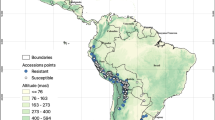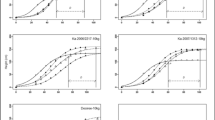Abstract
In the inter-Andean valleys of central Perú, two species of tuber moth, Phthorimaea operculella (Zeller) and Symmetrischema tangolias (Gyen), often occur simultaneously in stored potatoes. Traditional farming communities in the region produce a variety of native potatoes for local consumption. These include Solanum tuberosum subsp. andigena, the presumed predecessor of commercial potatoes, S. tuberosum subsp. tuberosum. In this study, we examined resistance against P. operculella in ten native Peruvian potato varieties (Casa blanca, Chispiadita, Madre de vaca, Mamaco negro, Misha, Chorisa, Mamaco rosado, Occa papa, Vacapa jayllo, and Yana tornasol). We also compared resistance in the first five of these varieties against S. tangolias. Varieties with pigmented periderms showed moderate resistance (30–40% against P. operculella in Mamaco negro, Mamaco rosado, and Yana tornasol and 55% against S. tangolias in Mamaco negro). All the other varieties were susceptible to both moth species. Small tubers tended to be the most resistant to the attack by both moths; however, this was not related to the availability of food for developing larvae, since pupal weight and development time were unaffected by the size of tubers. Similar responses by the two moths to native potatoes indicate that tuber resistance could be used to control the complex of tuber moths that damage potatoes in the Andes. We suggest that native potatoes, which are often easily introgressed with commercial potatoes, are a potential source of resistance against tuber moths.

Similar content being viewed by others
References
Celis C, Scurrah M, Cowgill S, Chumbiauca S, Green J, Franco J, Main G, Kiezebrink D, Visser RGF, Atkinson HJ (2004) Environmental biosafety and transgenic potato in a centre of diversity for this crop. Nature 432:222–225
Dangles O, Carpio C, Barragan AR, Zeddam J-L, Silvain J-F (2008) Temperature as a key driver of ecological sorting among invasive pest species in the tropical Andes. Ecol Appl 18:1795–1809
Dangles O, Mesias V, Crespo-Perez V, Silvain J-F (2009) Crop damage increases with pest species diversity: evidence from potato tuber moths in the tropical Andes. J App Ecol 46:1115–1121
Das GP, Magallona ED, Raman KV, Adalla CB (1993a) Growth and development of the potato tuber moth, Phthorimaea operculella (Zeller), on resistant and susceptible potato genotypes in storage. Philipp Entomol 9:15–27
Das GP, Magallona ED, Raman KV, Adalla CB (1993b) Screening different potato genotypes under different population pressures for resistance to the potato tuber moth, Phthorimaea operculella (Zeller), in storage. Philipp Entomol 9:7–14
Davidson MM, Butler RC, Wratten SD, Conner AJ (2006) Field evaluation of potato plants transgenic for a Cry1Ac gene conferring resistance to potato tuber moth, Phthorimaea operculella (Zeller) (Lepidoptera: Gelechiidae). Crop Prot 25:216–224
Douches DS, Westedt AL, Zarka K, Schroeter B (1998) Potato transformation to combine natural and engineered resistance for controlling tuber moth. HortSci 33:1053–1056
Douches D, Pett W, Visser D, Coombs J, Zarka K, Flecher K, Bothma G, Brink J, Koch M, Quemada H (2010) Field and storage evaluations of ‘SpuntaG2’ for resistance to potato tuber moth and agronomic performance. J Am Soc HortSci 135:333–340
Estrada RN, Valencia VL (1988) Desarrollo de cultivares de papa resistentes a la palomilla Phthorimaea operculella (Zeller), en Colombia. Rev Latinoam Papa 1:64–73
Fenemore PG (1979) Oviposition of potato tuber moth, Phthorimaea operculella Zell. (Lepidoptera: Gelechiidae); the influence of adult food, pupal weight, and host-plant tissue on fecundity. New Zeal J Zool 7:389–395
Golizadeh A, Razmjou J (2010) Life table parameters of Phthorimaea operculella (Lepidoptera: Gelechiidae), feeding on tubers of six potato cultivars. J Econ Entomol 103:966–972
Gurr GM, Symington CA (1998) Resistance to the potato tuber moth, Phthorimaea operculella (Zeller) (Lepidoptera: Gelechiidae), in potato (Solanum tuberosum ssp. tuberosum L.) tubers. Aus J Entomol 37:49–51
Horgan FG, Quiring DT, Lagnaoui A, Salas AR, Pelletier Y (2007) Periderm- and cortex-based resistance to tuber-feeding Phthorimaea operculella in two wild potato species. Entomol Exp Appl 125:249–258
Horgan FG, Quiring DT, Lagnaoui A, Salas AR, Pelletier Y (2010) Variations in resistance against Phthorimaea operculella in wild potato tubers. Entomol Exp Appl 137:269–279
Keller S (2003) Integrated pest management of the tuber moth in cropping systems of different agroecological zones. Tropical agriculture 11: advances in crop research 1. Margraf, Weikersheim, p 153
Kroschel J, Zegarra O (2010) Attract-and-kill: a new strategy for the management of the potato tuber moths Phthorimaea operculella (Zeller) and Symmetrischema tangolias (Gyen) in potato: laboratory experiments towards optimizing pheromones and insecticide concentration. Pest Manag Sci 66:490–496
Lacey LA, Kroschel J, Arthurs SP, de la Rosa F (2010) Microbial control of the potato tuber moth Phthorimaea operculella (Lepidoptera: Gelechiidae). Rev Colomb Entomol 36:181–189
Malakar R, Tingey WM (1999) Resistance of Solanum berthaultii foliage to potato tuberworm (Lepidoptera: Gelechiidae). J Econ Entomol 92:497–502
Malakar R, Tingey WM (2000) Glandular trichomes of Solanum berthaultii and its hybrids with potato deter oviposition and impair growth of potato tuber moth. Entomol Exp Appl 94:249–257
Malakar-Kuenen R, Tingey WM (2006) Aspects of tuber resistance in hybrid potatoes to potato tuberworm. Entomol Exp Appl 120:131–137
National Research Council (1989) Lost crops of the Incas: little-known plants of the Andes and the promise for worldwide cultivation. National Academy Press, Washington, p 415
Ochoa CM (1999) Las papas de Sudamérica: Perú. Allen, Lawrence, p 1036
Ochoa CM (2001) Las papas de Sudamérica: Bolivia. Centro Internacional de la Papa, Lima, p 535
Ojero MFO, Muerke JM (1985) Resistance of four potato varieties to the potato tuber moth, Phthorimaea operculella (Zell.) in storage. Insect Sci Appl 6:205–207
Ortiz R, Iwanaga M, Raman KV, Palacios M (1990) Breeding for resistance to potato tuber moth, Phthorimaea operculella (Zeller), in diploid potatoes. Euphytica 50:119–125
Pelletier Y, Horgan FG, Pompon J (2011) Potato resistance to insects. Am J Pl Sci Biotec 5:37–51
Raman KV, Palacios M (1982) Screening potato for resistance to potato tuberworm. J Econ Entomol 75:47–49
Raman KV, Iwanaga M, Palacios M, Egusquiza R (1981) Studies on identifying sources of resistance to the potato tuberworm, Phthorimaea operculella (Zeller). Am Potato J 58:517
Rêgo Lopes MT, Vendramim JD (2001) Resistência de genótipos de batata a Phthorimaea operculella (Zeller). Sci Agric 58:235–239
Rondon SI (2010) The potato tuberworm: a literature review of its biology, ecology and control. Am J Potato Res 87:149–166
Tisdale RA, Sappington TW (2001) Realized and potential fecundity, egg fertility, and longevity of laboratory-reared female beet armyworm (Lepidoptera: Noctuidae) under different adult diet regimes. Ann Entomol Soc Am 94:415–419
Valderrama AM, Velasquez N, Rodriguez E, Zapata A, Zaidi MA, Altosaar I, Arango R (2007) Resistance to Tecia solanivora (Lepidoptera: Gelechiidae) in three transgenic Andean varieties of potato expressing Bacillus thuringiensis Cry1Ac protein. J Econ Entomol 100:172–179
Acknowledgments
We thank Madeline Vera, Veronica Cañedo, Alberto Salas, and Rene Gomez at the CIP for their help during this research. We thank two anonymous reviewers for helpful comments that improved the manuscript. Funding was provided through a grant from the Canadian International Development Agency for North–South Cooperation in Agriculture and an NSERC-Discovery grant to Dan Quiring.
Author information
Authors and Affiliations
Corresponding author
Additional information
Edited by Jorge B Torres–UFRPE
Rights and permissions
About this article
Cite this article
Horgan, F.G., Quiring, D.T., Lagnaoui, A. et al. Life Histories and Fitness of Two Tuber Moth Species Feeding on Native Andean Potatoes. Neotrop Entomol 41, 333–340 (2012). https://doi.org/10.1007/s13744-012-0042-z
Received:
Accepted:
Published:
Issue Date:
DOI: https://doi.org/10.1007/s13744-012-0042-z




